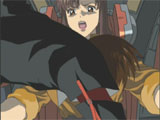

Quick Links:
Mobile Suit Gundam SEED, Volume 1: Grim Reality
The Mobile Suit Gundam franchise is a definitive set of works for the mecha genre, and a major part of why the Sunrise animation studio was able to grow so large. At the core of Gundam is the Newtypes - the next generation of giant robots and their pilots, whose introduction typically serves as a turning point to the conflict. The Gundam works typically focus on the tragic ironies of war, and as such are character-driven. Mobile Suit Gundam SEED differs slightly from its predecessors, but is also very much the same. Sunrise seems to have spared no expense in creating this highly-polished new Gundam, and the outcome was worth every penny.
Mobile Suit Gundam SEED takes place in year 71 of the Cosmic Era timeline (different from the origninal series' Universal Century timeline). At the beginning of SEED, a bitter war between the Earth and the ZAFT (who live in Earth-orbiting space colonies called PLANTs) has been raging for 11 months. Despite the fact that the Earth forces are much larger, there is no sign of an end to this conflict. This is partly due to ZAFT's advent of the Neutron Jammer - a device that disables nuclear weapons - after Earth destroyed one of the PLANTs in a devastating nuclear attack (later called the Bloody Valentine Tragedy). Another reason is that the ZAFT are Coordinators - genetically altered humans with enhanced physical and computational abilities. (People born naturally in this era are called Naturals.)
Gundam SEED gets the ball rolling quickly, with ZAFT forces approaching a supposedly neutral space colony named Heliopolis - where the Earth Alliance forces are secretly developing a new warship and five mobile suits. No sooner do we meet the peace-loving Kira Yamato (and his friends) than witness the erupting conflict. Kira just happens to find himself near one of the new mobile suits, which of course he was destined to pilot, and into which he is thrown by a shapely woman with a machine gun. By the way, among the attackers is Kira's best friend (Athrun Zala), and the woman joining him in the mobile suit is with the defending Earth forces....
The series thrusts the viewer into the fray even before finishing introductions for the main characters, but this definitely works in its favor. You feel the same outright confusion that Kira and his friends feel, as their peaceful colony comes under attack. The excitement is the show's chief strength in the beginning - but it also has other high points, like the classic political intrigue that is a staple of Gundam. Also a staple of Gundam is an intricate web of character relationships, a quality that SEED is exceptional at. Even with the first volume, the rivalries, friendships, and romances are difficult to keep track of, and the important part is that it's all interesting enough to want to keep track of. The series' start is a strong one, backing up all the excitement with solid developments.
Gundam SEED sports some pretty high production values for a TV series, and some big names in voice talent. The more notable appearances are up-and-coming character designer Hisashi Hirai, and actors Tomokazu Seki (Yzak Joule), Kotono Mitsuishi (Murrue Ramius), Souichirou Hoshi (Kira Yamato), and Houko Kuwashima (Natarle Badgiruel). The performances by all of the voice staff were marvelous, especially that of Toshihiko Seki (Rau Le Creuzet), which had a real charisma about it. The visuals were given significant attention as well, making good use of color and CG effects - though there is evidence of footage recycling going on in some scenes. The voice acting is where Gundam SEED really shines, but the flashy visuals certainly help the entertainment value.
The show's music isn't too shabby, either. The initial opening song for the series is by T.M.Revolution, a confessed Gundam fan. Titled Invoke, the song is a fast techno number - a style I can typically do without, but it grew on me in this case. The initial ending theme is more up my alley: Anna ni Issho Datta no ni (meaning "together we shared so much..."), by See-Saw. The song fits well with this Gundam's tragic irony - Kira having to defend his newer friends from his best friend. Toshihiko Sato's background music for the series is heavy on the melodrama, though given the pacing of this volume, it's effective.
Gundam SEED's first volume is pretty sparse on the disc extras, sadly. With a large number of characters and machines to choose from, it's a mystery as to why the only information available is on a mere two machines. Bandai does do a fine job of introducing commonly spoken terms and their meanings, through the case insert. I would have liked to see information on at least some of the sixteen-or-so main characters that show up in the first volume, especially since there are plenty more character introductions to come in subsequent volumes. The textless opening video included with the extras is a welcome addition, though, since it's a rather good-looking animation. Decent extras aren't terribly necessary, no doubt, but they do make a good product a little better.
At the onset, Mobile Suit Gundam SEED gives every reason to continue watching (provided that you aren't a disc-extras buff). The drama is potent and well-played, and the characters are worth getting to know better. SEED also serves as a fitting introduction to the Gundam franchise, because it incorporates core Gundam values (and does it right). I'll be following this one closely.
Distributor: Bandai Entertainment Creator: Sunrise Released: 2003
Video Quality: A Audio Quality: A Presentation: B- Content: A Overall: A-



